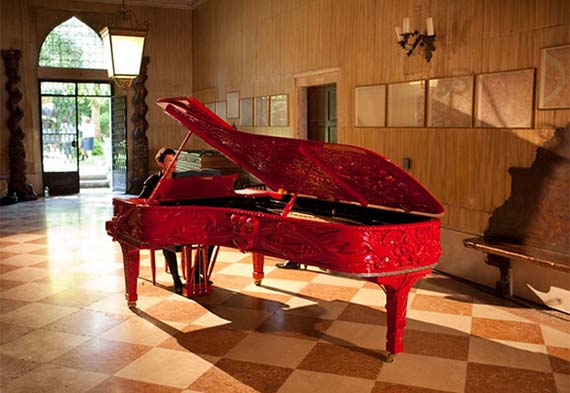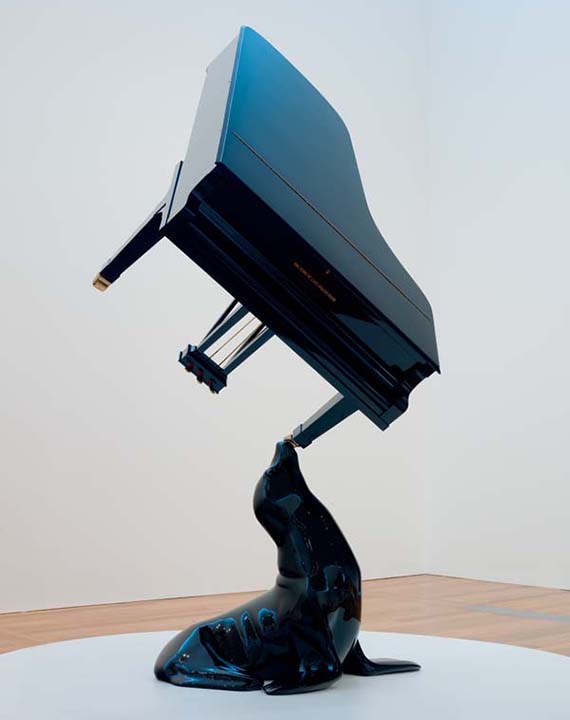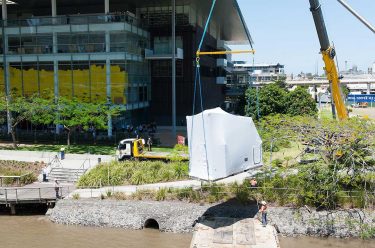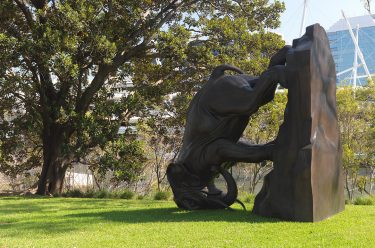
This major exhibition features new works and key loans, alongside a selection of works from the QAGOMA Collection, from one of New Zealand’s leading contemporary artists. The show sees the Gallery transformed into an immersive environment: a ‘memory palace’ in which visitors can discover sculptures and photographs spanning more than two decades of the artist’s practice. Here, we elaborate on two stunning works in the exhibition.
This is an edited excerpt from the Gallery’s exhibition publication Michael Parekowhai: The Promised Land (2015).
‘Michael Parekowhai: The Promised Land‘ is at GOMA from Saturday 28 March. Celebrate the opening weekend with special events and talks.
Barnett Newman famously described sculpture as the thing you bump into when backing up to look at a painting, and it is precisely this quality that Michael Parekowhai values in three-dimensional objects: their power to intrude on your space, to take you by surprise, and in the process, draw you into his cosmos of interwoven forms and narratives.
Time, performance, memory and reflection are some of the many devices Parekowhai puts to use in his works, and each, in different ways, reiterate the same point. As a medium, sculpture demands space, of course, but also time. The works themselves might not move, yet they take and demand time from us. They also exist as pieces of time made tangible: the time taken to make, the time we spend looking, and the time when we eventually move past them — from the present into our future while the sculpture remains where it is. By dramatising the temporal, Parekowhai animates and transforms the most ordinary everyday habit of looking.1
While primarily known as a sculptor of large-scale, intriguing works, performance has also been a recurring interest for Parekowhai, in one way or another. Often the references are elusive — a frozen moment caught on camera, or cast in fibreglass — or in objects that conjure the potential for activation. Parekowhai has often brought viewers to a place of stillness and silence, but with He Kōrero Pūrākau mo Te Awanui o Te Motu: story of a New Zealand river 2011, he flips that equation: this is a work you might hear before you see.
Many years in the making, this glossy red concert grand piano is covered in complex carvings, made in what looks like a traditional Māori style. Dense networks of pītau spirals, spirit guardians and mythical manaia creatures extend from its legs to the top of its open lid, set amid strips and circles of inlaid pāua shell, the light dancing as it glances off these intricate surfaces.2 As with his other works, this piano is a complex weave of associations and translations: in-jokes and snippets of personal biography sit alongside art-historical playfulness and big-picture cultural critique. Its varied and seemingly disparate references include, among other things, Jane Mander’s 1920 novel The Story of a New Zealand River and its translation into Jane Campion’s celebrated 1993 film The Piano. But this is also a playable piano that ‘engages both the potentiality and ultimately the actuality of performance’.3
While sculpture tends to sit solid and quiet, sound travels. Indeed, when Parekowhai heard the work played at its debut, he said, ‘no object can fill a room like sound can’, describing how, in the playing, ‘the object disappeared’.4 Notes heard in music act like words, marking the present in reference to what went before and what’s on its way, in a phrase or a score. In a gallery space, on average, visitors spend only around three seconds with a work of art before moving on, but He Kōrero Pūrākau mo Te Awanui o Te Motu: story of a New Zealand river deliberately gets in your way. It carves a path through space, and relies on time to draw you in. It takes time to understand the object making the music as well as its mutability. It is only when the work is played that it is made complete — a loop between artist and object, between performer and audience, is finally whole.

Elsewhere, Parekowhai has also created piano works that simply nod to performance. Perhaps one of the most succinct examples, in which time has been put on permanent pause, is The Horn of Africa 2006. Here, we bear witness to a suspended moment — a seal balancing a grand piano on its nose. The suggestion of an improbable performance is there, yet the possibility of sound and motion is absent, or rather, made still. This calls to mind the separation that exists between artist and audience, ‘the way the performer exists silently at the centre of an event that he can never quite join’.5 A beautifully poised object, the work also demonstrates ‘sculpture’s classic balance between gravity and grace’.6 The Horn of Africa is undeniably alluring, and the gleaming brilliance of its surface is perhaps as important as the object that makes it possible. It takes a lot of looking to find the artwork within its glossy black sheen — the dazzle only gets brighter when light hits it — and your own reflection is always getting in the way.7
Reflection is a useful device for Parekowhai and, as Ali Smith wrote in Artful, at one level:
. . . [it] means we see ourselves. At another, it’s another word for the thought process. We can choose to use it to look into the light of our own eyes, or we can be light sensitive, we can allow all things to move over and through us; we can hold them and release them, in thought.8
And this is precisely how The Horn of Africa operates. It’s highly shiny surface is one you can see yourself in, or rather it’s one placed so you can’t not see a vision of yourself in it. No matter where you move, no matter the angle of approach, it is impossible to escape the many reflections shining back, whether acknowledged by others, or by the silence in space when everyone’s gone home for the night.9 One of the simplest and most striking aspects of freestanding sculpture is the way it draws your attention to ‘the many-sidedness of any art experience’, an effect that is amplified ten-fold when the work is highly reflective.10 We approach such a sculpture wondering where the artist stands, and when confronted by our own selves looking, we’re left wondering where we do.
You might say that Parekowhai’s solitary objects carry the echoes and reflections of all the others Parekowhai has made, as well as those he is yet to make, evoking memory impressions for himself and the viewer that zing backwards and forwards across time. Just as time translates our lives into sequence, and into meaning, it is from within this fractured space that we connect with Parekowhai’s work. From another vantage point, Victor Klemperer once wrote of ‘a shatteringly present past’; a nod, perhaps, to the way stories tend to repeat themselves, but always to new ends11 and, as Michael Parekowhai’s practice also suggests, always towards one particular end — the renewal of vision.
Endnotes
1 Briony Fer, The Infinite Line, Yale University Press, New Haven and London, 2004, p.3.
2 Justin Paton, ‘Weighing in, lifting off Michael Parekowhai in Venice’ in Michael Parekowhai: On First Looking into Chapman’s Homer, Michael Lett Publishing, Auckland and Roslyn Oxley9 Gallery, Sydney, 2011, p.23.
3 Gregory Burke, ‘The virtuoso effect’ in Michael Parekowhai: On First Looking into Chapman’s Homer, p.34.
4 Michael Parekowhai, http://arts.tepapa.govt.nz/on-the-wall/he-korero-purakau-mo-teawanui-o-te-motu-story-of-a-new-zealand-river/5267, accessed 29 September 2014.
5 Paton, p.xiv.
6 Paton, p.xiv.
7 Paton, p.xiv.
8 Ali Smith, Artful, Penguin Books, London, 2013, p.186.
9 Paton, p.xv.
10 Paton, p.xv
11 Quoted in Smith, p.38. Above and previous: Installation view of He Kōrero Pūrākau mo Te Awanui o Te Motu: story of a New Zealand river 2011 at the Venice Biennale, 2011 / Wood, ivory, brass, lacquer, steel, ebony, paua shell, resin, mother of pearl / 2011-0046-1/A-N to N-N / Purchased 2011 with the assistance of the Friends of Te Papa / Collection: Te Papa Tongarewa Musuem of New Zealand / Image courtesy: Te Papa Tongarewa Musuem of New Zealand / Photograph: Michael Hall

